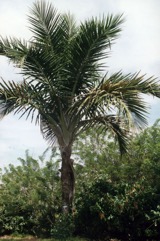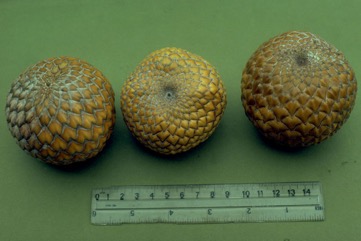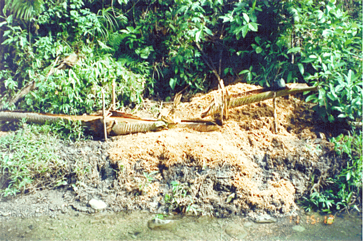Solomon’s sago

It is a tropical plant. It grows in North Solomons Province of Papua New Guinea and the Solomon Islands. It grows in less swampy sites than sago. It needs fertile soils. It can grow up to 880 m altitude. It suits hardiness zones 11-12.
Also known as:
Ao'o, Atava, Ato, Atovo, Edeve, Endeve, Hapiri, Kalovo, Karama, Karamava, Karmo, Katua, Katuva, Kinenda, Lao, Name, Naota, Nat, Natho, Nggoe, Nive, Nungona’a, Pina, Rao, Sao, Tete-na, Thao, Wanda
Synonyms
- Coelococcus salomonensis Warburg
- Metroxylon bougainvillense Becc.
Edible Portion
- Pith starch, Palm heart
Where does Solomon’s sago grow?
Found in: Australia, Bougainville, Pacific, Papua New Guinea, PNG, SE Asia, Singapore, Solomon Islands, Vanuatu
Notes: There are 8 Metroxylon species. This palm has very large leaves which provide excellent thatch for house rooves. The seeds were also sold as “ivory nuts” for button manufacture.
Status: In Papua New Guinea the sago starch is used as a reserve food and for special functions.
Growing Solomon’s sago
Cultivation: Plants are grown from seeds.
Edible Uses: The starch is extracted from the trunk and eaten cooked. The palm cabbage is edible.
Production: Time to maturity is 12-15 years. The palm is felled, the outer hull stripped off then the pith pounded and the starch extracted by washing in water and letting the starch settle out. Four men can cut, process and collect the starch from one palm in 4-5 hours. When a team do this work it is allocated amongst cutters, shredders, washers and packers.
Nutrition Info
per 100g edible portion| Edible Part | Energy (kcal) | Protein (g) | Iron (mg) | Vitamin A (ug) | Vitamin c (mg) | Zinc (mg) | % Water |
|---|---|---|---|---|---|---|---|
| - | - | - | - | - | - |
Solomon’s sago Photos



References
References Solomon’s sago
Balick, M.J. and Beck, H.T., (Ed.), 1990, Useful palms of the World. A Synoptic Bibliography. Colombia p 645, 653,
Barrau, J., 1958, Subsistence Agriculture in Melanesia. Bernice P. Bishop Museum Bulletin 219 p 35
Beccari, 1918, Annals of the Royal Botanic Garden. Calcutta 12(2):1-231.
Connell, J., 1977, Hunting and gathering: The forage economy of the Siwai of Bougainville. ANU Development Studies Centre Occasional Paper No. 6 p14-21.
Connell, J., and Hamnett, M.P.,m 1978, Feast or famine: sago production in Bougainville. J. of the Polynesian Society 87(3):231-241.
Cundall, P., (ed.), 2004, Gardening Australia: flora: the gardener's bible. ABC Books. p 893
Denschr. Kaiserl. Akad. Wiss. Wien, Math.-Naturwiss. Kl. 84:60-62. 1913
Dowe, J.L., 1989, Palms of the South-West Pacific. Palm and Cycad Society of Australia. p 30
Elevitch, C.R.(ed.), 2006, Traditional Trees of the Pacific Islands: Their Culture, Environment and Use. Permanent Agriculture Resources, Holualoa, Hawaii. p 493
Etherington, K., & Imwold, D., (Eds), 2001, Botanica's Trees & Shrubs. The illustrated A-Z of over 8500 trees and shrubs. Random House, Australia. p 478
Flora of Solomon Islands
French, B.R., 1986, Food Plants of Papua New Guinea, A Compendium. Asia Pacific Science Foundation p 27
French, B.R., 2010, Food Plants of Solomon Islands. A Compendium. Food Plants International Inc. p 28
Guppy, H.B., 1887, Sagus sp., The Solomon Islands and their Natives, London. 83, 90, 303.
Henderson, C.P. and Hancock, I.R., 1988, A Guide to the Useful Plants of Solomon Islands. Res. Dept. Ministry of Agriculture and Lands, Honiara, Solomon Islands, p 34
Jones, D.L., 1994, Palms throughout the World. Smithtonian Institution, Washington. p 268
Jones, D.L., 2000, Palms of Australia 3rd edition. Reed/New Holland. p 184
Kajewski, S.F., 1946, Plant Collecting in the Solomon Islands. Journ. of the Arnold Arboretum 27(3): 292-304.
Oliver, D.L., 1955, A Solomon Island Society. Kinship and Leadership among the Siwai of Bougainville. Harvard. p42-43, 480
Ribbe, C., 1903, Zwei Jehre unter den Cannibalen der Salomo-Inseln, Dresden. p34-36.
Riffle, R.L. & Craft, P., 2003, An Encyclopedia of Cultivated Palms. Timber Press. p 388
Schumann & Lauterhach., 1901, Fl. Deutsch Schutzg. Nachtr. 606.
Yanaka, T., 1976, Tanaka’s Cyclopedia of Edible Plants of the World. Keigaku Pub. Co., Tokyo.
Warburg, O, 1896, Coclococcus salomonensis, Ber. Deutch. Bot. Ges. 14:141.
Warburg, O., 1989, Die Steinnusspalme der Salomons-Inseln. Der Tropenpflanzer 2(8):254-255
Whitmore, T.C., 1973, On the Solomon’s Sago Palm. Principes. Vol 17(2):46-48
World Checklist of Useful Plant Species 2020. Royal Botanic Gardens, Kew
Yen, D.E., 1974, Arboriculture in the Subsistence of Santa Cruz, Solomon Islands. Econ Bot.. 28:252 & 256